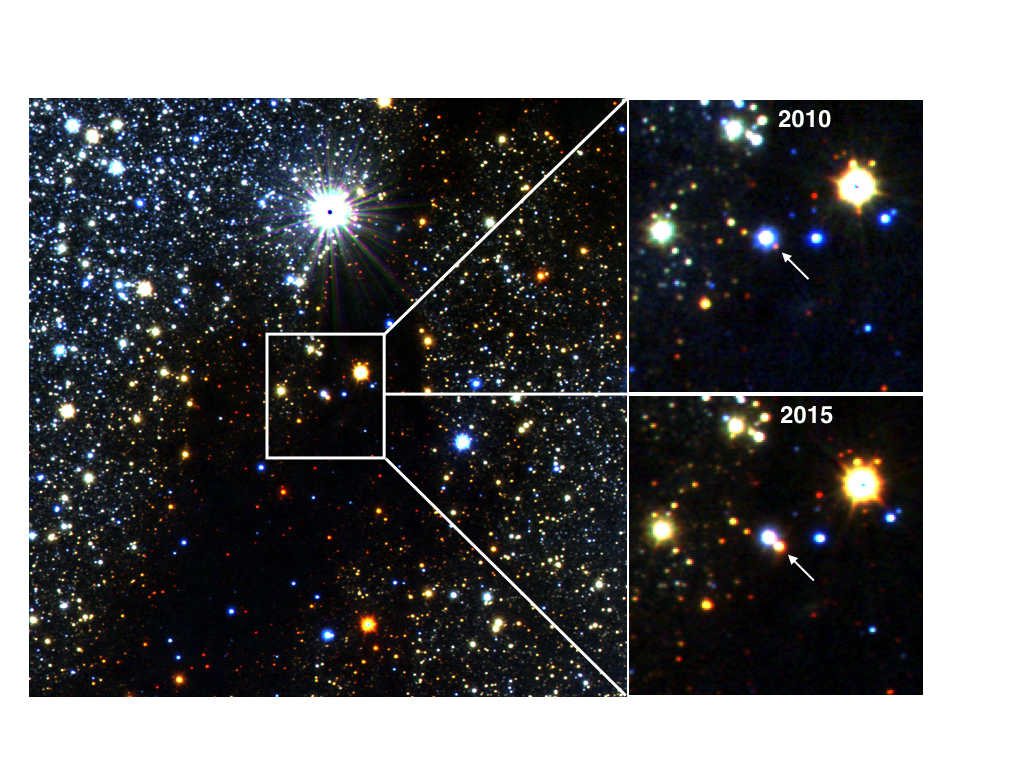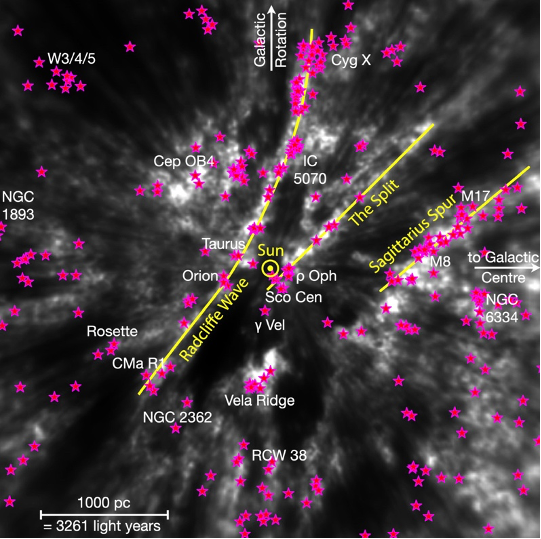Star Formation
(Forbrich, Krause, Kuhn, Lucas, de Souza)
Understanding how stars form within the Universe is one of the fundamental questions in modern astrophysics and is central to many other fields, including the evolution of galaxies and the formation of planets. At UH we have an active group working on the formation of stars within the Milky Way galaxy and the neighbouring Andromeda Galaxy, where we can study the processes of star formation in much greater detail than in more distant galaxies.
We lead extensive multi-wavelength surveys of the Milky Way at infrared wavelengths (VVV, VVVX and previously UKIDSS GPS) and the Andromeda Galaxy in the submillimetre waveband (SMA ADAMS), while also focussing on individual nearby star-forming regions with the James Webb Space Telescope and the Very Large Array. In addition, we are heavily involved in planning the next generation of radio surveys with the Square Kilometre Array and its precursors.
Eruptive Variability in YSOs
Eruptive variability in Young Stellar Objects (YSOs), is a poorly understood phenomenon wherein newborn stars suddenly brighten by a factor of 100 or more and remain bright for at least several decades (FU Orionis systems or FUors) or merely for about a year but then repeat at irregular intervals (EX Lupi systems or EXors). The physics of these events is unclear despite decades of work, mainly because of the small number of known objects) that have been available for study until recently. They are known to be associated with a sudden increase in the rate of accretion of matter from the protostellar disc on to the star, known as episodic accretion. Theorists have explored numerous types of accretion disc instability without yet being able to solve it. External triggers such as a stellar fly-by are also possible.
Historically, the known examples were almost all found by optical studies. The advent of the VISTA Variables in the Via Lactea survey (VVV), the first large infrared time domain survey, unveiled a large population of eruptive variable YSOs that are hidden from view in visible light by their own birth shroud of dust and gas. Many of these sources have a mixture of the properties of FUors and EXors.
Episodic accretion is significant for planet formation and the physics of protoplanetary discs, since it is hard for massive planets to form if ice particles in the disc are melted and evaporated by occasional outbursts. If episodic accretion is common to all YSOs, as is suspected, it can resolve some long-standing problems in star formation, namely that YSOs in nearby star forming regions and show a huge spread of luminosities and are typically under-luminous. Low average luminosity would be due to the great majority of the cycle being spent in the slowly accreting state, while the scatter would be due the effect of different accretion/eruption histories on the temperature and luminosity of each star.

Orion Nebula Cluster
We are conducting radio surveys of young stellar objects in the Orion Nebula Cluster ("The Orion Radio All-Stars"), targeting hundreds of objects with the VLA, VLBA, and the Atacama Large Millimetre Array (ALMA). The focus here is on statistically establishing the nature of the radio emission as potentially extreme forms of space weather when compared with the present-day sun, as well as on extreme flaring variability and proper motions - using new observational capabilities in preparation of SKA science.
Star formation in a photoionising environment
Star-forming regions are often harsh environments where young planet-forming circumstellar discs are exposed to high levels of ultraviolet radiation emitted by nearby massive stars. The 'eXtreme Ultraviolet Environments' (XUE) collaboration is an international project to investigate the effects of external irradiation on protoplanetary discs via James Webb Space Telescope (JWST) spectroscopy. Dr Mike Kuhn is PI of a Cycle 3 JWST programme on the destruction of protoplanetary discs in the Carina Nebula's Trumpler 14 cluster. NIRSpec observations will trace atomic and molecular lines from photoevaporating discs and reveal differences in disc properties that may be connected to proximity to ionising sources. Ongoing XUE projects model the structure and chemistry of irradiated protoplanetary discs based on mid-infrared JWST spectra from NGC 6357.

The distribution of star formation and interstellar dust clouds in the Milky Way
Research on the large-scale distribution of star formation within our Galaxy makes use of survey data available to CAR. Catalogues of young stars are used to map the 3D locations of star-forming regions in the Solar neighbourhood and investigate their association with our Galaxy's spiral structure. This includes analysing the connections between young stellar populations and maps of Galactic gas and dust and examining the kinematics and orbits of young stars within the Galactic disc.

The formation of globular clusters
An ongoing project in our group is a theoretical investigation of the hypothesis that the formation of globular clusters leads to the creation of a super-massive star, with a mass of order 1000 solar masses. This hypothesis is the best current explanation for the observation of kilomasers in a small number of external galaxies. These are methanol masers with luminosities intermediate between typical stellar masers and megamasers, which are associated with Active Galactic Nuclei, Luminous Infrared Galaxies and starburst galaxies.